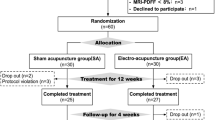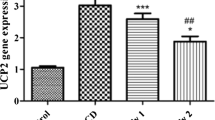Abstract
Nonalcoholic fatty liver disease (NAFLD) has become a major health concern worldwide. The aim of this study was to investigate the effect and mechanism of electroacupuncture (EA) on nonalcoholic fatty liver disease (NAFLD) in rats induced by high-fat diet (HFD). A model of nonalcoholic fatty liver in rats induced by high fat was established. Rats in the control group were fed standard diet. The rats in model group and EA group were fed with HFD. From the fifth week, the rats in EA group were treated with EA (“FengLongXue,” “YinLingQuanXue,” “SanYinJiaoXue”) for 2 weeks respectively. EA could significantly reduce serum alanine aminotransferase (ALT), aspartate aminotransferase (AST), serum triglyceride (TG), serum cholesterol (TC), and serum cytokines, and improve liver histopathological changes in rats. EA also could regulate the levels of Sirt1/NF-κB pathway in rat liver. EA relieved liver injury in NAFLD rats, and its mechanism may be related to the regulation of Sirt1/NF-κB pathway in rats. This is the first report that electroacupuncture alleviates liver inflammatory reaction of nonalcoholic fatty liver by enhancing Sirt1 expression and inhibiting NLRP3/NF-kB signal pathway.






Similar content being viewed by others
References
Weiß, J., M. Rau, and A. Geier. 2014. Non-alcoholic fatty liver disease: Epidemiology, clinical course, investigation, and treatment. Deutsches Ärzteblatt International 111 (26): 447.
Videla, L.A., and P. Pettinelli. 2012. Misregulation of PPAR functioning and its pathogenic consequences associated with nonalcoholic fatty liver disease in human obesity. PPAR Research 2012 (4): 107434.
Lee, J., Y. Kim, S. Friso, and S.W. Choi. 2017. Epigenetics in non-alcoholic fatty liver disease. Molecular Aspects of Medicine 54: 78–88.
Jornayvaz, F.R., V.T. Samuel, and G.I. Shulman. 2010. The role of muscle insulin resistance in the pathogenesis of atherogenic dyslipidemia and nonalcoholic fatty liver disease associated with the metabolic syndrome. Annual Review of Nutrition 30 (1): 273–290.
Liu, Z., et al. 2016. Deletion of Nrf2 leads to hepatic insulin resistance via the activation of NF-κB in mice fed a high-fat diet. Molecular Medicine Reports 14 (2): 1323–1331.
Choi, Y.H., J.K. Bae, H.S. Chae, Y.M. Kim, Y. Sreymom, L. Han, H.Y. Jang, and Y.W. Chin. 2015. α-Mangostin regulates hepatic steatosis and obesity through SirT1-AMPK and PPARγ pathways in high-fat diet-induced obese mice. Journal of Agricultural and Food Chemistry 63 (38): 8399–8406.
Andrade, J.M.O., et al. 2014. Cross talk between angiotensin-(1–7)/Mas axis and sirtuins in adipose tissue and metabolism of high-fat feed mice. Peptides 55 (5): 158–165.
Zain, S.M., et al. 2011. Does polymorphism in patatin-like phospholipase 3 gene (PNPLA3) confer risk of nonalcoholic fatty liver disease (NAFLD) in multiethnic Malaysian population? Drug Metabolism Reviews 43 (1): 56–57.
Pastori, D., et al. 2015. Lysosomal acid lipase activity in patients with non-alcoholic fatty liver disease. In The International Liver Congress.
Ezquerro, S., L. Méndez-Giménez, S. Becerril, R. Moncada, V. Valentí, V. Catalán, J. Gómez-Ambrosi, G. Frühbeck, and A. Rodríguez. 2016. Acylated and desacyl ghrelin are associated with hepatic lipogenesis, β-oxidation and autophagy: Role in NAFLD amelioration after sleeve gastrectomy in obese rats. Scientific Reports 6: 39942.
Liu, J., P. Wang, S.L. Douglas, J.M. Tate, S. Sham, and S.G. Lloyd. 2016. Impact of high-fat, low-carbohydrate diet on myocardial substrate oxidation, insulin sensitivity, and cardiac function after ischemia-reperfusion. American Journal of Physiology. Heart and Circulatory Physiology 311 (1): H1–H10.
Plubell, D.L., P.A. Wilmarth, Y. Zhao, A.M. Fenton, J. Minnier, A.P. Reddy, J. Klimek, X. Yang, L.L. David, and N. Pamir. 2017. Extended multiplexing of tandem mass tags (TMT) labeling reveals age and high fat diet specific proteome changes in mouse epididymal adipose tissue. Molecular & Cellular Proteomics: MCP 16 (5): 873–890.
Karbaschi, R., H. Zardooz, F. Khodagholi, L. Dargahi, M. Salimi, and F.S. Rashidi. 2017. Maternal high-fat diet intensifies the metabolic response to stress in male rat offspring. Nutrition and Metabolism 14 (1): 20.
Priscilla, D.H., M. Jayakumar, and K. Thirumurugan. 2015. Flavanone naringenin: An effective antihyperglycemic and antihyperlipidemic nutraceutical agent on high fat diet fed streptozotocin induced type 2 diabetic rats. Journal of Functional Foods 14: 363–373.
Zhang, Z., Q.I. Xiaohong, and W.U. Cuizhen. 2007. Stereologic analysis on therapeutic effect of chitosan and traditional Chinese medicines on rat fatty liver. Jiangsu Medical Journal 33 (1): 62–64.
Bao, J.F., et al. 2017. Effects of resveratrol on liver cell precancerous lesions in rats which induced by high fat diet and diethyl nitrosamine. Chinese Journal of Health Laboratory Technology 27 (08): 1101–1104+1117.
Ren, Y., Y. Gu, W. Wang, J. Wang, X. Li, Y. Wang, H. Gao, X. Dong, and Y. Tian. 2016. Expression of the significance of silent information regulator type-1 in Angioimmunoblastic T-cell lymphoma is greater association with tumorigenesis and has strong implications for adverse prognosis. Cell Cycle 15 (12): 1545–1551.
Yu, L.I., et al. 2011. Overexpression of SIRT1 in the liver deacetylates X-box binding protein 1 and attenuates hepatic steatosis and insulin resistance in ob/ob mice. Journal of Pharmaceutical Sciences 65 (11): 1613–1617.
Zhang, H.S., X.Y. Chen, T.C. Wu, W.W. Sang, and Z. Ruan. 2012. MiR-34a is involved in Tat-induced HIV-1 long terminal repeat (LTR) transactivation through the SIRT1/NFκB pathway. FEBS Letters 586 (23): 4203–4207.
Dela, P.A., et al. 2005. NF-kappaB activation, rather than TNF, mediates hepatic inflammation in a murine dietary model of steatohepatitis. Gastroenterology 129 (5): 1663–1674.
Wang, X.-A., et al. 2014. Interferon regulatory factor 3 constrains IKKβ/NF-κB signaling to alleviate hepatic steatosis and insulin resistance. Hepatology 59 (3): 870–885.
Oneta, C.M., and J.F. Dufour. 2002. Non-alcoholic fatty liver disease: Treatment options based on pathogenic considerations. Swiss Medical Weekly 132 (35–36): 493–505.
Author information
Authors and Affiliations
Contributions
B.M performed experiments; H.A drafted manuscript; Z.S analyzed data; and P.L conceived and designed research and edited and revised manuscript.
Corresponding authors
Ethics declarations
Conflict of Interest
The authors declare that they have no conflict of interest.
Additional information
Publisher’s Note
Springer Nature remains neutral with regard to jurisdictional claims in published maps and institutional affiliations.
Rights and permissions
About this article
Cite this article
Ma, B., Li, P., An, H. et al. Electroacupuncture Attenuates Liver Inflammation in Nonalcoholic Fatty Liver Disease Rats. Inflammation 43, 2372–2378 (2020). https://doi.org/10.1007/s10753-020-01306-w
Published:
Issue Date:
DOI: https://doi.org/10.1007/s10753-020-01306-w




